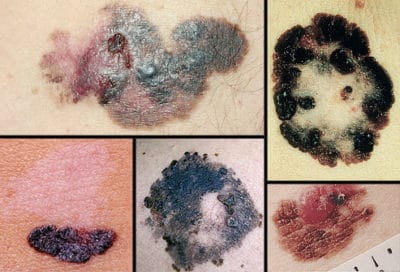By HHTM Staff Writer
Tucson is the world center for Melanoma and skin cancer, which is nothing to boast about. That dubious title gives those of us in health care in Tucson an extra burden of care when working with patients.
Audiologists are not dermatologists or physicians of any type. We are hearing communication specialists and our diagnoses are made in those terms: type and degree of hearing loss, degree of communication difficulty. We do not diagnose medical conditions, nor should we. However, we know a lot about what ear and surrounding facial tissue SHOULD look like and we are remiss if we see something suspicious and fail to bring to our patients’ attention and recommend follow-up. The collage of pictures above are examples of melanomas.
We bring this up because we should be pointing out a slight facial blemish that deserve scrutiny. Patients should take our recommendation to heart. A colleague did this and the spot turned out to be an early cancer which was treated quickly and completely. This is not a one-time occurrence: a number of patients throughout the years have had similar stories in various practices here in Tucson. Unfortunately, not everyone has heeded the concerns and the results in several of those cases have been very sad.
It is not just Tucson residents who need to maintain a high level of suspicion when it comes to facial skin lesions. Skin cancer may occur more often in Tucson but it can and does occur all over the world. And it’s not just Audiologists who should exercise awareness. A recent study of beauticians suggests that they, too, are in a good position to serve as early detectors of skin cancers. Here’s a summary from the research:
Results indicated that the surveyed hair professionals already screen customers for suspicious lesions, and thus function informally as lay health advisors. For example, during the month preceding the survey, 37.1% of the participants reported examining more than 50% of their customers’ scalps, 28.8% looked at more than 50% of necks, and 15.3% examined more than 50% of customers’ faces, which is consistent with the fact that practitioners predominantly view the back of the head. Fifty-eight percent reported suggesting consultation with a physician for a suspicious mole, and more than 90% agreed or strongly agreed that this is necessary for a mole that is bleeding or enlarging.
Photo: Courtesy of WebMD






